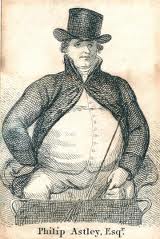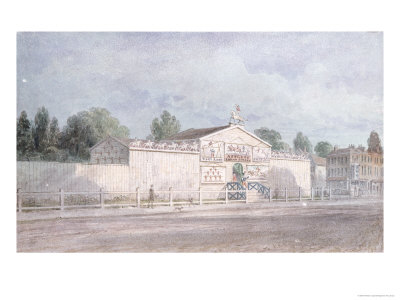Annotation:Astley's Ride
ASTLEY'S RIDE. AKA and see "Astley's Hornpipe," "Drumley's Ride," "Ashley's Ride," "Ashley's Flag (2)," "Leslie's Hornpipe." English, Country Dance (2/4 time) or Hornpipe. D Major (Huntington, Kennedy, Raven): C Major (Harding's). Standard tuning (fiddle). AABB.
Philip Astley was one of the remarkable personages of the 18th century, credited with founding the modern circus. Born the son of a cabinet maker from Newcastle-Under-Lyme, Astley early on developed a fascination with horses. At the age of seventeen he borrowed a horse and joined the 15th Dragoons as a rough rider and horse-breaker and was soon sent overseas with the unit to serve under the King of Prussia. Astley proved to be independent and resourceful, and aquired a reputation for bravery on and off the battlefield (he was also said to have been a sturdy six feet tall with a booming voice). He enhanced his career by saving the life of the wounded Duke of Brunswick and when he was discharged from the cavalry in 1768 he was given the regimental commander's white charger, Gibralter, as a leaving present.

Still a young man, Astley's ambition next was to start a riding school, although he lacked the funds to go into business directly by himself. He started by securing a position as a horse breaker with a riding school master in the fashionable resort of Islington (which featured tea gardens and other amusements). This and simlar resorts provided recreation for the well-to-do and attracted many riding masters who provided public entertainment with demonstrations of skill in order to build up a clientele. It was at Islington that Astley met and married an accomplished horsewomen, whose name is only known to us as "Petsy." Luck was the vehicle for his next career move, however, when he found a diamond ring on Westminster Bridge. The item brought him £60, with which he bought a second horse, and he and Petsy began to give unlicensed open-air equestrian displays at Glover's "Halfpenny Hatch" field in Lambeth. The hat was passed at every performance. Luck again smiled on Astley when he helped King George III subdue a spirited horse, again near Westminster Bridge, earning a reward of a performing license.
Only a year or two after his discharge from the military Astley was in a position launch his career. He purchased land close to his lucky Westminster Bridge and constructed a roped-off enclosure that he surrounded with stands, later adding a canvas roof. Those wishing to be entertained at his "Royal Grove," as he called it, could sit in the stands or, for a lesser amount, secure a standing space. Astley hired a drummer-boy to accompany his act, to add punctuation to his tricks. His main inspiration of his early period, however, was to realize that a circular ring rather than a straight list would allow his audience consistently better viewing and a more cohesive, flowing performance, and, in addition, a larger audience could be accommodated. Best of all, Astley discovered performing in a circular ring generated centrifugal force, a fact Astley quickly capitalized on in his routines. Through experimentation, he discovered the optimum diameter for the performance ring was forty-two feet.

In 1777 Astley expanded his equestrian show to include a strongman, Signor Colpi, and by 1780 had employed two clowns but the name of Fortunelly and Burt, and a number of acrobats who performed rope-vaulting tricks. He hired other noted equestrians, Miller, Griffin and Jones, but it was Astley who was the artistic creator and director of the show.
The title of the melody, "Astley's Ride," refers to yet another innovation by this talented performer. Although he was judged to be the greatest horseman of his age, Astley was not prideful, and was able to poke fun at himself in his art. He developed an act, a clown act called Billy Buttons, or The Tailor's Ride to Brentford, based on the popular tale of a tailor with rather poor riding skills, who attempts to ride a horse to Brentford to vote in an election. The tailor, acting the buffoon, has difficulty in mounting, then falls off the horse when it starts up at a fast pace. The Billy Buttons act became an institution at Astley's circus (though Astley had other of his performers learn the act after a time), and indeed it survived for a century as an integral part of circus offerings.
Astley's luck did stumble at times. His Royal Grove burned in 1794, was rebuilt (as "Astley's Royal Ampitheatre") and burned again in 1803 followed by yet another rebuilding. In 1782 a former member of Astley's company, Charles Hughes, struck out on his own with "The Royal Circus," much to the discomfort of his old employer, but Astley was at the same time opening a venue in Paris for his brand of entertainment.
When the antiquarian Jean-Baptiste Malchair was in Oxford in 1789 he noted the melody from street musicians playing on "Flute a bec and Tambour." "Astley's Ride" also appears in the (writer Thomas) Hardy family music manuscripts, and it appears in the 1840 music manuscript collection of multi-instrumentalist John Rook (Waverton, Cumbria) as "Ashley's Flag (2)" and the c. 1883 music manuscript collection of County Leitrim piper and fiddler biography:Stephen Grier as "Astly's Hornpipe." The second strain of the Pennsylvania collected "Frank Keeney (1)" appears in in this tune. Astley is also mentioned in the note to "annotation:Grand March in the Siege of Valenciennes." The first strain of "Astley's Ride" is also shared with "Lord Harrington's March," but subsequent parts differ.

